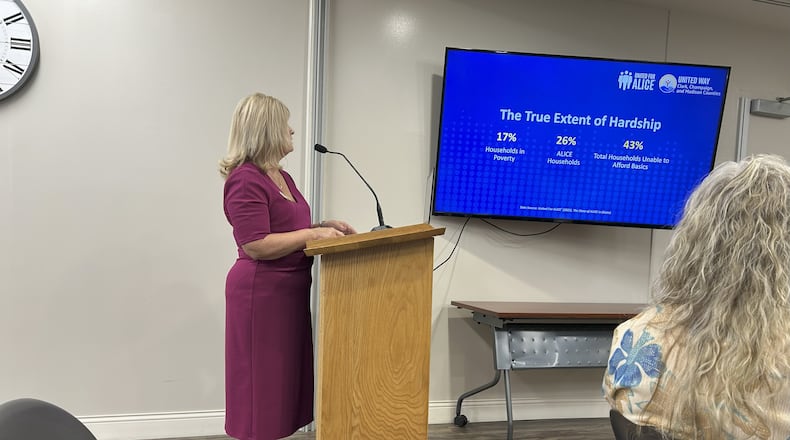Pedraza gave a presentation at the Clark County Commission meeting about the ALICE (asset limited, income constrained, employed) report, which is households that bring in income above the federal poverty level but less than the cost of basics.
This study is done every two years, with the last one in 2023. Since then, there’s been an additional strain on the community because of the influx of population, Pedraza said, so numbers have “likely skyrocketed to insurmountable numbers.”
“I think this report is helpful to understand our community much better and to understand what it actually takes for our employers when they’re hiring people to be able to have folks who are on a livable wage,” said Commissioner Charles Patterson.
The number of households not able to afford basic necessities has increased since 2021, as nearly 1,000 households moved from below the ALICE threshold to below the poverty line, and the number of households living in poverty grew by 3% and ALICE households grew by 2%.
Out of 57,013 households in 2021, more than 21,000 households lived below those lines, which includes almost 9,000, or 16%, living in poverty and more than 12,000, or 21%, ALICE households.
“That’s very, very concerning. That is why you are seeing an increase in the number of people going to the food banks, the number of people asking for rent, utility assistance. The numbers actually indicate what’s happening here in our community,” Pedraza said.
Pedraza said we all know ALICE — it can be our neighbor, a friend, a family member, a colleague — such as child care providers, retail salesperson, cashiers, waiters, delivery drivers, gas station attendants and others.
“ALICE is someone that you see every day,” she said. “All of these ALICE workers are engines in our economy and our daily lives.”
ALICE individuals have to face choices each day such as should they pay for heating or cooling, buy healthy food for their families, buy prescriptions or pay rent.
Pedraza said there are several factors that impact a household’s ability to afford basics, including systemic barriers in the communities, as well as increasing cost of expenses and wages that don’t keep up. The ALICE Household Survival Budget for families helps understand this better, which is the minimum cost of housing, childcare, food, transportation, healthcare, technology and taxes.
For a family of four in Ohio, the Household Survival Budget was $79,224 in 2023. But when the full-time wages of two of the most common jobs in the state are combined — personal care aide and stock worker/order filler — that family, with both working adults, brought in $65,840 — nearly $14,000 short of the cost of basics.
In Clark County, only 19% of working-age people had a full-time salary job and 26.5% of workers in Ohio’s 20 most common jobs couldn’t make ends meet, which is not those under the ALICE threshold but those that still had to sacrifice essentials like electricity, food and childcare.
“When we factor in the Federal Poverty Level, which was $30,000, the dilemma facing countless ALICE families becomes clearer — when the Federal Poverty Level is used to determine eligibility for assistance programs such as SNAP, it’s no wonder there are so many families locked out of the supports that are so desperately needed," Pedraza said.
ALICE households span all ages, genders, races, ethnicities, living in urban, suburban and rural communities, but some groups experience hardship at disproportionate rates because of systemic barriers. For example, 70% of Black households in the county fell below the ALICE threshold (61% in 2021), compared to 42% (49% in 2021) Hispanic and 41% White (34% in 2021).
There are also differences by household age and type that are under the ALICE thresholds — 79% of households are single-female-headed, compared to 52% single-male-headed, 38% single and 14% married; and 73% of households are under the age of 25, compared to 38% for ages 25 to 44.
There are also fluctuating numbers depending on where you live in the county. Households were more likely to struggle in the city of Springfield with 56% (53% in 2021), compared to the least likely to struggle in Pike Twp. with 20% (19% in 2021). In between those areas include 41% in Madison Twp. and 29% in Springfield Twp.
“(This means) that it’s a combination of the federal poverty guidelines as well as what it takes to actually survive with the finances that they’re bringing in, in comparison to what it takes to actually pay your rent, to pay all of your bills,” Pedraza said.
“It’s no mistake that the cities with the largest population are facing the most challenges. We are in crisis, and with our new population in crisis we must fight for our communities.”
United For ALICE is the national research organization from New Jersey whose work is backed by more than 300 experts nationwide that has given a name and way to quantify the ALICE population.
About the Author


